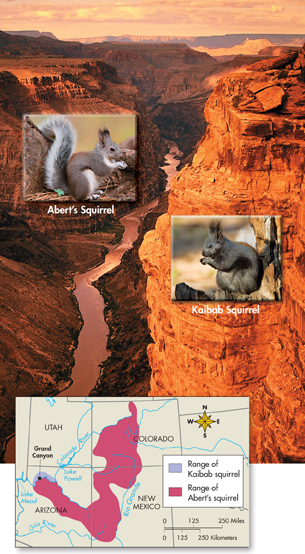Behavioral Isolation Suppose two populations that are capable of interbreeding develop differences in courtship rituals or other behaviors. Behavioral isolation can then occur. For example, eastern and western meadowlarks are similar birds whose habitats overlap. But, members of the two species will not mate with each other, partly because they use different songs to attract mates. Eastern meadowlarks don't respond to western meadowlark songs, and vice versa.
Geographic Isolation When two populations are separated by geographic barriers such as rivers, mountains, or bodies of water, geographic isolation occurs. The Abert's squirrel in Figure 17–12, for example, lives in the Southwest. About 10,000 years ago, a small population became isolated on the north rim of the Grand Canyon. Separate gene pools formed. Genetic changes that appeared in one group were not passed to the other. Natural selection and genetic drift worked separately on each group and led to the formation of a distinct subspecies, the Kaibab squirrel. The Abert's and Kaibab squirrels are very similar, indicating that they are closely related. However, the Kaibab squirrel differs from the Abert's squirrel in significant ways, such as fur coloring.
Geographic barriers do not always guarantee isolation. Floods, for example, may link separate lakes, enabling their fish populations to mix. If those populations still interbreed, they remain a single species. Also, a geographic barrier may separate certain organisms but not others. A large river may keep squirrels and other small rodents apart but probably won't isolate bird populations.

FIGURE 17–12 Geographic Isolation Abert's squirrel and the Kaibab squirrel are distinct subspecies within the same species. Their gene pools are separate. Interpret Visuals What geographic barrier separates the two populations of squirrels?
dTemporal Isolation A third isolating mechanism, known as temporal isolation, happens when two or more species reproduce at different times. For example, suppose three similar species of orchids live in the same rain forest. Each species has flowers that last only one day and must be pollinated on that day to produce seeds. Because the species bloom on different days, they cannot pollinate one another.
 In Your Notebook Explain how temporal isolation can lead to speciation.
In Your Notebook Explain how temporal isolation can lead to speciation.
Table of Contents
- Formulas and Equations
- Applying Formulas and Equations
- Mean, Median, and Mode
- Estimation
- Using Measurements in Calculations
- Effects of Measurement Errors
- Accuracy
- Precision
- Comparing Accuracy and Precision
- Significant Figures
- Calculating With Significant Figures
- Scientific Notation
- Calculating With Scientific Notation
- Dimensional Analysis
- Applying Dimensional Analysis




